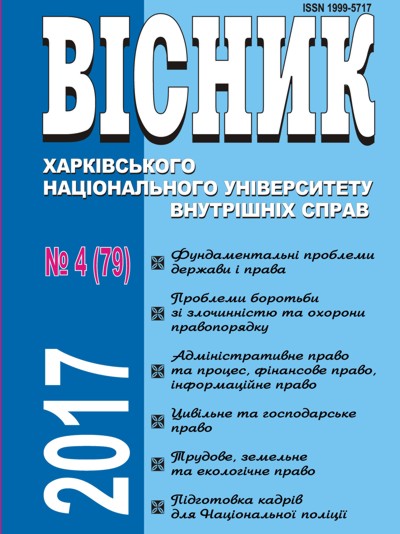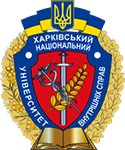Historical and legal analysis of the formation and development of the modern court apparatus in Ukraine
Abstract
The author using the method of historical and legal analysis has researched the formation and development of the court apparatus in Ukraine. The following historical and legal stages of the formation and development of the modern court apparatus in Ukraine have been defined and analyzed: 1) the times of Kievan Rus – there were princely, boyar, community and church courts; the court was not separated from the administration; the judges were feudal lords, posadniks and volost owners, and their assistants – tiuns and judges dealing with criminal cases; a feudal lord solved court cases together with the court nobility; judges dealing with criminal cases, sword-bearers and slanderers began to carry supporting functions of the court; 2) the time of Ukraine being under the authority of the Polish kingdom and the Lithuanian Principality – the noblemen’s courts were formed: zemski (judge, deputy judge, clerk and his assistants – subscriptions), town (lieutenant generals, headman or voivode, chief judge and clerk) and sub-comoros; the judicial agency of the Pany-Rada functioned (marshal, chancellor, pidskarbii, hetman, voivode and others) and the magistrates (city council and the bench, where mayors and counselors, retailers and prefects respectively worked);3) the times of the Zaporozhian Sich – the military officer served as a judge; commander of Cossack camp (Hetman) was the highest judicial agency, and from the middle of the XVII century – the appellate institution; the function of technical assistance was performed by a military clerk who headed the Sich Chancellery; 4) the time of Ukraine being in the Russian Empire – the absence of a single judicial system (provincial, conscientious, court council, zemski courts, magistrates and town hall, the General Court, as well as tribal courts – church, military, volost, and in some provinces – local and general courts); 5) the period of the UNR, the Directorate and the Soviet period – the positions of the secretary general of the court cases, prosecutors and senior prosecutors appeared; people’s courts, the councils of people’s judges and revolutionary tribunals were organized; internship judges (modern assistants) worked; 6) the period of the proclamation of Ukraine’s independence and the adoption of the Constitution of Ukraine – the development and approval of a number of legal acts that contributed to the formation of a separate branch of the judiciary; 7) the period of the development of democratic principles of judicial proceedings – the actual formation and development of the court apparatus, the definition of staffing, the organizational structure of the apparatus and the status of court employees, the regulation of other aspects of their activities, further improvement of the court apparatus in the context of the judicial reform.
It has been proved that the court apparatus is an important component of the court as the state authority that carries out the organizational provision of the activity of judges, courts and justice in the whole, represented by the system of staffing positions according to the approved organizational structure in accordance with the procedure envisaged by the current legislation; this apparatus has the appropriate management, organizational and regulatory powers.
The author has emphasized on the necessity of further development of the court apparatus and improvement of its administrative and legal provision.
Downloads
References
Керимов Д. А. Методология права (предмет, функции, проблемы философии права). М. : Аванта+, 2001. 560 с.
Смирнов С. Г. Задачник по истории науки: от Фалеса до Ньютона. М. : Мирос ; МАИК «Наука / Интерпериодика», 2001. 368 с.
Москвич Л. М. Становлення та розвиток судових систем. Вісник Вищої ради юстиції. 2010. № 3. С. 73–81.
Гусарєв С. Д., Тихомиров О. Д. Юридична деонтологія (Основи юридичної діяльності) : навч. посіб. Київ : Знання, 2005. 655 c.
Ніколаєнко Н. Сутність та особливості історико-порівняльного методу правових досліджень М. Ковалевського. Віче. 2010. № 14. URL: http://veche.kiev.ua/journal/2110/ (дата звернення: 11.11.2017).
Коркунов Н. М. Русское государственное право. СПб., 1909. Т. 1. 630 с.
Сердюк В. В. Верховний Суд України: витоки, сучасність, перспективи : монографія. Київ : Істина, 2008. 304 с.
Радченко О. М. Історичний аспект запровадження посади помічника судді в українських судах // Посібник помічника судді загального суду / Акбарова І. М., Бондаренко М. С., Глос М. та ін. ; упоряд. та ред. Осики І. М. Київ, 2010. Розд. 1. С. 15–29.
Меленко С. Г. Суд і процес у Давньоруській державі // Незалежний суд – гарантія захисту прав, свобод та законних інтересів людини і громадянина : матеріали Всеукр. наук.-практ. конф., 30 трав. 2009 р. Чернів¬ці : Чернівец. нац. ун-т, 2009. С. 200–205.
Кульчицький В. С., Тищик Б. Й. Історія держави і права України : навч. посіб. Київ : Атіка, 2001. 320 с.
Гавриленко О. А., Колесніков С. Д. Право Київської Русі // Київська Русь: державність, культура, право : навч. посіб. / В. А. Греченко, О. А. Гавриленко, О. О. Гавриленко та ін. Харків, 2000. Розд. 3. С. 52–74.
Бойко І. Й. Органи влади і право в Галичині у складі Польського Королівства (1349–1569 pp.) : монографія. Львів : Видав. центр ЛНУ ім. Івана Франка, 2009. 628 с.
Кульчицький В. С., Тищик Б. Й. Історія держави і права України : підруч. для студентів ВНЗ. Київ : Ін Юре, 2008. 624 с.
Охотницька Н. В. Становлення судової системи України (1991–2012 рр.): історико-правовий аспект : дис. … канд. юрид. наук : 12.00.01. Львів, 2016. 212 с.
Меліхова Ю. Суд і суддя в історичній реальності (від Київської Русі до сьогодення). Вісник Академії правових наук. 2011. № 1. С. 217–228.
Про Концепцію судово-правової реформи в Україні : постанова Верховної Ради України від 28.04.1992 № 2296-XII. Відомості Верховної Ради України. 1992. № 30. Ст. 426.
Дудченко О. Ю. Історія виникнення та розвиток посади керівника апарату суду // Керівник апарату суду: вступ до професії : посіб. з теми «Управління судом». Кн. 1. Київ, 2013. Підрозд. 3.1. С. 33–38. URL: http://pdf.usaid.gov/pdf_docs/PA00M181.pdf (дата звернення: 22.11.2017).
Про судоустрій і статус суддів : закон України від 02.06.2016 № 1402-VIII. Відомості Верховної Ради України. 2016. № 31. Ст. 545.
Типове положення про апарат місцевого, апеляційного судів : затв. наказом Держ. суд. адміністрації України від 28.09.2012 № 115 // Судова влада України : сайт. URL: https://court.gov.ua/userfiles/tipove-polozh-pro-aparat.pdf (дата звернення: 14.11.2017).
Про державну службу : закон України від 10.12.2015 № 889-VIII. Відомості Верховної Ради України. 2016. № 4. Ст. 43.




